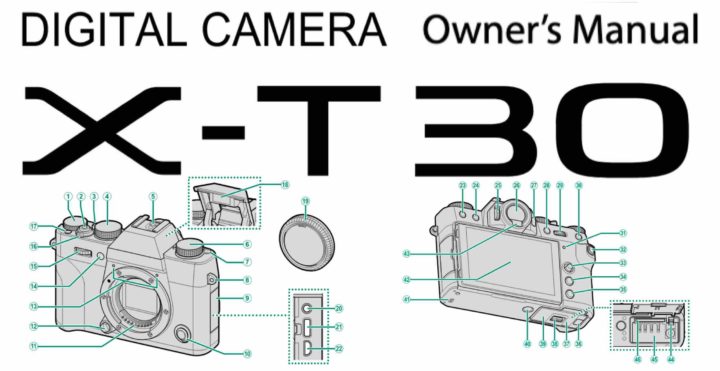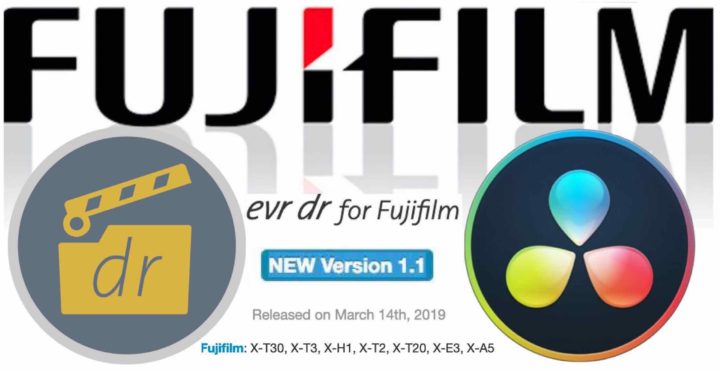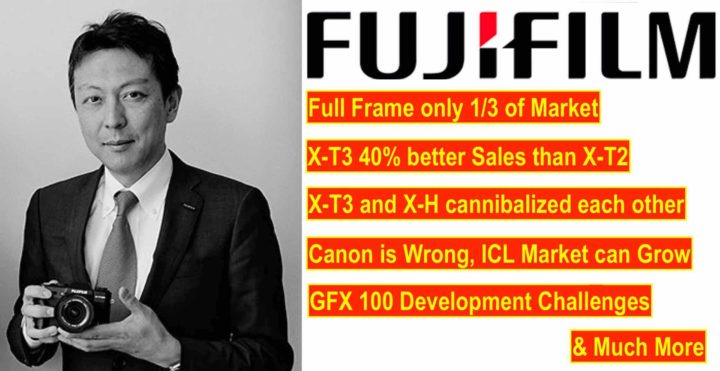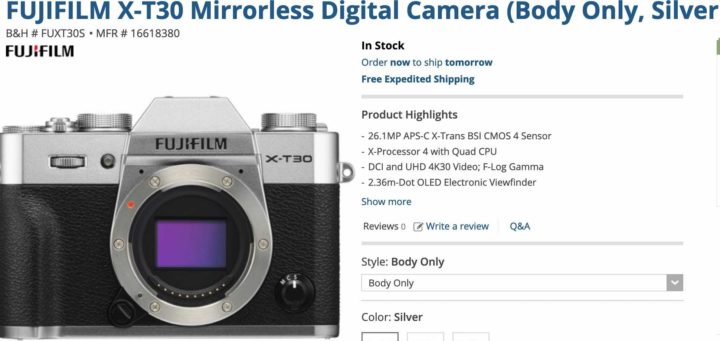Fujifilm X-T30 Owner’s Manual Released

Fujifilm X-T30 Manual
The Fujifilm X-T30 owner’s manual is now online here (html version – PDF version).
Fujifilm X-T30 (save up to $300): BHphoto, Adorama, AmazonUS, FocusCamera
Follow FujiRumors on Facebook, Instagram, RSS-feed and Twitter
Exif Video Resolved DR adds Fujifilm Support for EXIF Metadata Import in DaVinci Resolve

As you might know DaVinci Resolve can’t read the metadata of many DSLRs and Mirrorless cameras. A solution to this problem is now offered by Exif Video Resolved DR.
Exif Video Resolved DR is a plugin for ExifTool, that allows you to import camera EXIF metadata such as ISO, Aperture, Shutter, Lens Type, Gamma, Color Space, Focal Point, etc. to Davinci Resolve, giving you the ability to see a lot more metadata info in your Media Pool with just a few click.
The good news for Fujifilm users is, that on March 14, Exif Video Resolved DR ver. 1.1 added support for Fujifilm X-T30, Fujifilm X-T3, Fujifilm X-H1, Fujifilm X-T2, Fujifilm X-T20, Fujifilm X-E3 and Fujifilm X-A5.
Exif Video Resolved DR is not free, but very affordable. You can get the Fujifilm version for €5 and the version with all cameras supported for €14 (or €20 if you buy Windows and Mac version together). Future updates should be free.
You can check all the details at evrapp.cloud and here is the online instruction manual.
It’s my pleasure to break again the news here on FujiRumors, and if you want to be always and consistently the first to get the news and rumors around the Fujifilm world, here is what you have to do:
Follow FujiRumors on Facebook, RSS-feed, Twitter, Youtube and Instagram
Join our Owners Groups
- Fujifilm GFX User Group
- Fujifilm X-T User Group
- Fujifilm X-H User Group
- Fujifilm X-E User Group
- Fujifilm X-Pro User Group
- Fujifilm X100 line Group
Join our Facebook Pages
Screenshots & Tutorial Videos
Fujifilm X-T30 Beats Sony a6400 in Autofocus Stills Tracking, but Sony A6400 Better for Video and Vice Versa
Fujifilm X-T30 vs Sony A6400 – Part 1
Gerald Undone has often critiqued Fujifilm quite hard and never recommended to buy Fujifilm, except for the Fujiflim X-T3. He now reviewed the Fujifilm X-T30 and compares it to the Sony A6400.
Interesting to note that he gets better autofocus tracking results in stills with the Fujifilm X-T30 over the Sony a6400. But the a6400 is the better choice for video autofocus.
Down below are the key points of his comparison.
DEAL ALERT: Today only you can save up to 30% on selected SanDisk SD-card at BHphoto here.
Fujifilm X-T30 Review
- less video features than Fujifilm X-T3
- overheats much faster than X-T3 in video, hence shorter recording limit
- X-T30 is a serious upgrade from X-T20
- Mic/USB-C/HDMI ports are to close together. If you use one, you block access to the other. You don’t have this problem with Fujifilm X-T3
- X-T30 battery life lasts 65 minutes when shooting 4K. You can 90 minutes when shooting 1080p
- When used with external video recorder, the camera shuts down due to overheating after 31 minutes
- to extend video-life up, turn boost mode off (it affects mainly brightness and EVF refresh rate), pull the LCD screen away from body, mount it on tripod (no hand-holding), less AF-C. He got up to 69 minutes recording this way
- X-T3 is definitely worth the money if you shoot lots of video. But for shorter family/travel videos, the X-T30 is great
X-T30 Pros
- Sony lenses tend to be a bit larger, hence X-T30 system is smaller
- in video the X-T30 has higher bit rate (200 Mbps) whereas the A6400 shoots at 100 Mbps. But higher bit rate does not mean automatically better image quality
A6400 Pros
- Sony A6400 tripod mount does not block access to battery door
- A6400 has a better screen design (flippy selfie screen)
- A6400 lasts longer when it comes to overheating and with high temperature setting enabled, it can last for hours
- no recording time limits, so no external recorder required
- true 120 fps at 1080p
- 3.5 mic jack (X-T20 has 2.5mm mic jack)
- Sony wins for overall video recording usability
- battery life is similar, but Sony is a little bit better (around 10 to 15 minutes longer recording time and 50 more stills)
- A6400 Sony’s RAW buffer is about twice at large
Autofocus in Video
- for Video, the Sony wins by a little bit
- X-T30 offers eye detection in video (the Sony A6400 only face detection), but the X-T30 is just a tad slower to catch up to a subject when moving in and out from the camera. The Sony manages to maintain the focus better
- Both are great, but side by side, you can see the X-T30 autofocus drift a little
- You can improve this on the X-T30, by increasing autofocus speed, but then it makes focus transition a bit too jumpy. The Sony has a nice balance of offering nice transitions while still locking on the face
Autofocus in Stills
- in burst photo shooting continuous focus, the Fujifilm X-T30 beats the Sony A6400. The Fujifilm X-T30 hit a 100% hit rate in his test, whereas the Sony A6400, even with more expensive full frame glass, hit about 80%. The X-T30 consistently nails focus
NOTE: the Fujifilm X-T3 will get the same new AF algorithm in a firmware update in April. This means Tony Northrup’ eye-AF comparison between the Fujifilm X-T3 vs Sony A6400, Sony A6500, Sony A9 and Sony A7rIII will be obsolete soon and I hope he will retest it.
Noise and Image Quality
- likely due to the lens he used, he got sharper results with the Sony A6400. He used the Sigma f/1.4 contemporary crop lens vs the Fujinon XF23mm f/2 [admin note: he uses Adobe, too. If he played with the RAW files, then Capture One Pro 12 or the new Adobe enhance detail feature would have given different results]
- Fuji is 1 stop noisier, when equalizing the image brightness [admin note: comment about it below]
Conclusions
- He recommends the Sony A6400 due to more flexibility: selfie screen, better battery life, better video capabilities, deeper grip etc.
- X-T30 might be the better travel camera, since more compact
Fujifilm X-T30 vs Sony A6400 – Part 2
Fujifilm Managers Q&A: Canon is Wrong, Full Frame only 1/3 of Market, X-T3 sold 40% Better than X-T2, Fast Lenses for GFX and More

Fujifilm Managers Interview
Just yesterday we shared a CP+ interview with Fujifilm managers here. Today it’s already time for another one, this time with Toshihisa Iida (the manager who said Fujifilm will never go full frame) and Makoto Oishi.
It’s again an interesting one, that also becomes very technical when it comes to analyzing the autofocus system and lets imaging-resource conclude that Fujifilm’s PDAF technology is arguably the most advanced on the market.
Down below you can find the key points and some images of the interview. The complete one can be checked out at imaging-resource here.
Market Future & Canon Predictions
- Fujifilm totally disagrees with Canon’s prediction, that ILC business is going to contract by half over the next two years
- Market will depend on innovation that will come
- Fujifilm believes there is room for further grow
- Some markets will decline, but other markets have still potential to grow (Asian market)
Full Frame
- Customers should have different options
- Currently full frame has 1/3 of the market by value
- 2/3 of market is predominantly APS-C, Micro Four Thirds, and some medium-format
- other manufacturers focus on full frame, this might open opportunities for Fujifilm as long as they keep up innovating APS-C and MF
- mainly X-T3 and GFX 50R helped Fujifilm to grow by 10% total volume growth
- APS-C vs FF is not just about sensor size, but also the lens size, lens weight, overall cost, or the speed, the 4K movies
- people judge the system more on the overall package
Fujifilm X-T3 vs X-H line
- sold better than expected
- Fujifilm X-T3 sold 40% better than X-T2 if you compare to same period since launch
- X-T3 and X-H1 have cannibalized each other
- with the new lower X-H1 price tag, X-T3 and X-H1 sit nicely next to each other
- H-series and T-series will coexist for the future, but we need to clearly differentiate the lineup without confusing customers
Lenses
- XF200mmF2 is not only for sports, but also for portraits for very creamy bokeh and concerts for example
GFX System
- Fujifilm GFX 50R sales are above expectation and factory is very busy
- Fujifilm GFX 100 design is almost final, very early firmware, and IBIS still does not work
- GFX 100 megapixel autofocus: same sensor structure as the X-T3
- GFX 100 has almost zero competition, because FF is only at 50MP and other medium format cameras are very expensive
- Fujifilm thinks at multi-shot high-res shooting mode for GFX100, but has not decided yet
- designing IBIS is a real challenge for big MF sensor
- Fujifilm has no idea about how many stops IBIS they will achieve [FujiRumors leaked internal press sheets that show they aim at 5 stops]
- Fujifilm is still improving image quality via firmware
- GFX100 launch in first half 2019 for around $10,000
- Fujifilm GFX 50S most popular lens is the GF 32-64mmF4
- Fujifilm GFX 50R most popular lens is the GF 45mmF2.8
- GFX 50S owners have more lenses than GFX 50R owners
- GFX owners complaint about the lack of more fast lenses for the system and Fujifilm is taking into consideration their feedback
- Fujifilm listens to customers and tries to make their wishes happen, but sometimes their wishes become reality is very difficult and challenging
- As bright as possible, as small as possible, as affordable as possible…
- same team works on GFX and X. One R&D budget and depending on needs they are flexible to shift their focus
Autofocus
- X-T30 has improved algorithm which will come to X-T3
- CMOS sensor is always reading by lines. So it isn’t very suitable for horizontal phase-difference […] technically we can make a cross-type system but normally, subjects are more… and horizontally-arranged PDAF pixels support them better
- Fujifilm could do vertical AF correlation, but hasn’t felt the need to do it
- 8% of pixels are phase detection pixels (high density), good for low-light and high-frequency subjects
- signal and phase pixel are read separately
- we used to have like 60 regions within each AF point, but now 240
- depending on the light level, the X-T3 can “bin” PDAF pixels together (basically just adding their contents) to get a better signal/noise ratio, and so be able to determine focus even in very dim lighting. Depending on how you do this, you’ll trade-off some ability to see the finest details, but it can really help in very low-light conditions
DON’T FORGET TO FOLLOW and JOIN:
- FUJIRUMORS: Facebook / RSS-feed / Instagram / Youtube / Twitter
- USER GROUPS: GFX User Group / X-H User Group / X-E User Group / X-T User Group / X-Pro User Group / X100 line Group
- SPECIFIC PAGES: X-T Page / X-H Page / GFX Page






